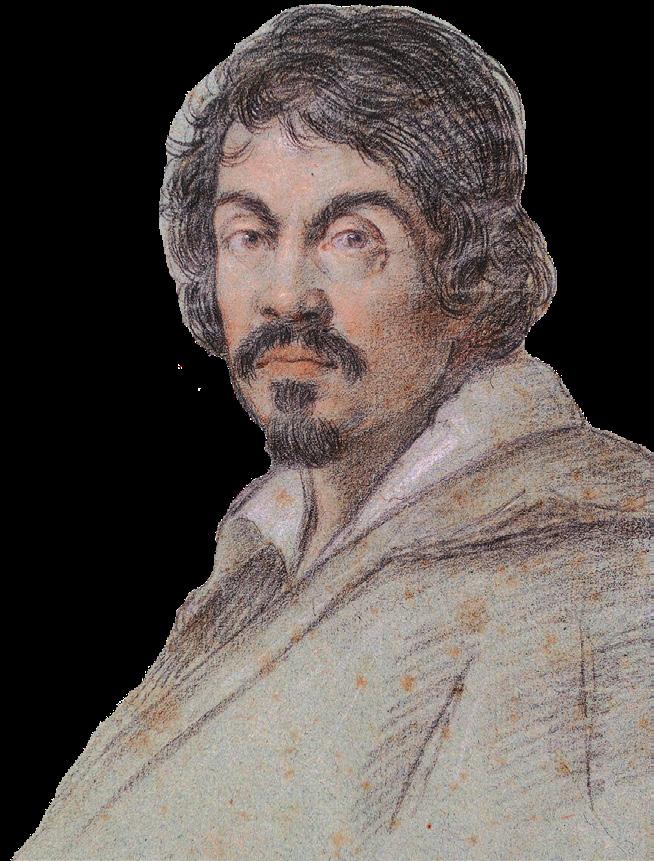
3 minute read
Caravaggio: His mercurial life and works
Thomas Bristow
According to the art historian Andrew Graham-Dixon, Caravaggio lived ‘a life sacred and profane’. Born Michelangelo Merisi da Caravaggio in 1571 in Milan, the family moved east to the town from which he was to take his name in order to escape the plague. Caravaggio was raised in poverty and by 1584 had lost both of his parents. However, that same year he began a four year apprenticeship with the painter Simone Peterzano. In 1592 he moved to Rome, having quarrelled with and injured a policeman. It was this tendency for violence which was to follow him for the rest of his life. Rome was where he fourished, fulflling commissions for churches and patrons, but once again his temper got the better of him, and he fed to Naples with a death sentence for murder. Throughout his life he was notorious for fghting and was an extremely disagreeable man by all accounts. In 1607 Caravaggio travelled to Malta and then to Sicily, before returning to Naples in 1609 and being involved in yet another violent altercation. In 1610, in the coastal town of Porto Ercole, Caravaggio died in uncertain circumstances. Theories range from syphilis, lead poisoning and murder, but what was certain was that death had fnally caught up with him.
Advertisement
What then of the works produced during this turbulent life? Simply put they’re nothing short of spectacular. In his early life, Caravaggio was probably infuenced by the regional Lombard style which emphasised simple but naturalistic detail, providing a departure from the tense and grandiose compositions of Mannerism. His earliest known painting Boy Peeling Fruit (1592-93) is an excellent example of this. It is a calm scene, in which a curiously pensive young man peels an unidentifed fruit, but the trademark use of chiaroscuro makes it none the less striking. Indeed it is this chiaroscuro (light-dark) for which Caravaggio was to become most famous. He developed and employed the technique with great skill, illuminating whole fgures in bright light against dark backgrounds, creating a heightened sense of drama in wholly naturalistic depictions.
But it wasn’t always like this. In another earlier composition, The Musicians (c.1595), the use of light is far more subtle. The two central fgures catch the viewer with their strange doll-like faces, and the composition itself feels crowded and uncomfortable. Similarly, in The Cardsharps (c.1594) the chiaroscuro is much less prominent. The painting depicts a young man who is being cheated at cards by another young man and his older master. From our view, the cheat reaches for the hidden cards, and their use against the naïve youth is imminent. The bold difference in colour of the three fgures’ clothing provides a strong contrast and the immediacy of the scene is brilliant. This work caught the eye of Cardinal Francesco Del Monte, who bought the painting and became Caravaggio’s frst big patron.
In 1599, Caravaggio was commissioned to produce three pieces for the Contarelli Chapel in the church of San Luigi dei Francesci. The painting to the left of the altar, The Calling of Saint Matthew, is one of his most famous works, and rightly so. Having seen this in person, I can attest to its impact. The fgures are rendered in vivid detail, and highlighted by the masterful use of chiaroscuro. The light seemingly foods in from the right, but almost only on the men depicted, rendering them clear against a plain background. Christ stands in the shadows, seemingly directing the light towards one of two men sat at the table (the identity of Matthew is debated). The strong use of light against a gloomy room captures perfectly a moment of great spiritual awakening and conversion. It is a perfect example of the dramatic style for which
Caravaggio was thenceforth famous.
Caravaggio continued to paint biblical scenes for the rest of his time in Rome, refning the use of light and darkness to produce such works as the violent and shocking Judith Beheading Holofernes (c.1602), and one of my favourites, Saint Jerome Writing (c.1605). Here Saint Jerome reads intently, his outstretched hand holds a quill and morbidly placed upon the desk is a skull. Caravaggio continued his religious work in Naples, producing the altarpiece The Seven Works of Mercy (c.1607), and in Malta was inducted as a Knight of Malta. Before being expelled from the order in 1608 for violent quarrelling again, he painted his largest work, The Beheading of St John the Baptist (1608). It is 370 by 520 centimetres, and considered by some to be ‘one of the most important works in Western painting’. This was also the only painting that he signed, perhaps fttingly in the blood which gushes onto the foor.
The legacy of Caravaggio cannot be overstated. Infuencing subsequent masters from Gentileschi to Rubens, his commanding use of fundamental elements such as colour, light and darkness combined to create a unique style flled with the drama and violence that his subjects required. When considering his tumultuous life, I think we can see much of Caravaggio in his works, self- portraits aside of course. Despite only signing one painting, he is present in all of them. Whether in the mysterious, psychological complexity of his fgures, or the plain violence that we know him for today.










